How often to water grapes in spring, summer and autumn: rules and methods of watering
It is obvious that for stable and abundant fruiting, grapes require a sufficient amount of nutrient moisture. This means that a logical question arises before a novice winegrower: "How to water grapes in the summer during the growing season - when and how often to do it?"
Next, you will receive answers to all basic questions regarding the proper watering of grapes in summer, as well as in spring and autumn.
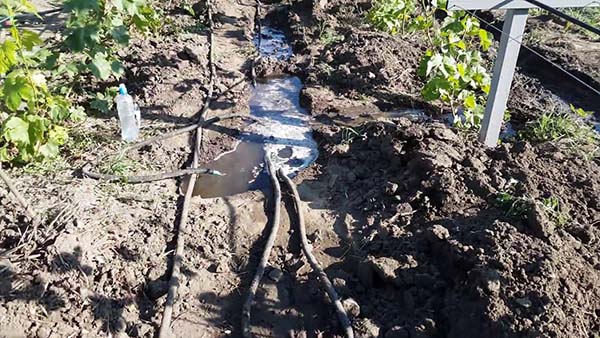
Content
How to properly water grapes
Basic rules for watering:
- Watering is recommended warm and settled water (it is very good to have a barrel or some kind of container standing in the sun in the country).
Watering with cold water is always stressful for the plant.
On the other hand, many experienced winegrowers water directly from a well (or from a water supply system) with cold water and everything is in order ...
By the way! But water-charging autumn watering can be done with cold water from the water supply.
- It is very effective to combine watering grapes with its dressing (using organic and mineral fertilizers).
That is, you add fertilizers to the water for irrigation, which ones depend on the phase of development of the bush.
- Water must necessarily reach to the root layer, i.e. to a depth of 30-40 centimeters (this is a minimum, better - up to 40-60 cm).
Note! The main roots of grapes lie at a depth from 30-40 cm (root heel of the bush), and the length (depth) of deep tap roots can even reach several meters.
- Frequency and specific amount of moisturerequired for watering grapes depend on many factors (climatic features of the growing region, rainfall, soil type, since it is necessary to water twice as often on sandy and sandy loam soils, irrigation method, depth of groundwater), which means that certain quantitative characteristics will be individual for each specific vineyard.
Important! You should not water the grapes often and little by little, especially if you use surface watering. In this case, moisture does not enter the root layer, moreover, the top layer of the soil is compacted and air permeability decreases, and without oxygen, the roots of the plant cannot breathe.
- Usually, for 1 adult bush (for 1 square meter of food area) in 2-4 weeks need to 40-60 liters.
- If the soil is clay, then you should not water the grapes too often, especially if you made a drainage well. Otherwise, a swamp will form there, the water will stagnate and the roots will rot.
Interesting! Why is it important to know what is the depth of the groundwater at your site?
The fact is that thanks to a powerful, branched root system that penetrates deep into the ground, grapes are able to independently extract the necessary moisture.
Actually, this is why grapes are able to survive in hot and arid growing regions.
However, it should be understood that stable and good fruiting and life of bushes on the brink survival - this is not the same thing, because in the second case, there can be no talk of abundant fruiting.
How to water grapes in the first year after planting
What must be taken into account precisely during this period is that the young seedling only managed to take root in a new place, but had not yet managed to build up a sufficient root system to independently extract moisture at a depth. This is why it is very important to regularly water the grapes after planting, especially in the summer (June-July), i.e. during hot and dry periods.
The soil in the trunk circle should always be slightly damp.
But in August-September, watering of the grapes must be stopped so that the vine has time to mature well before wintering.
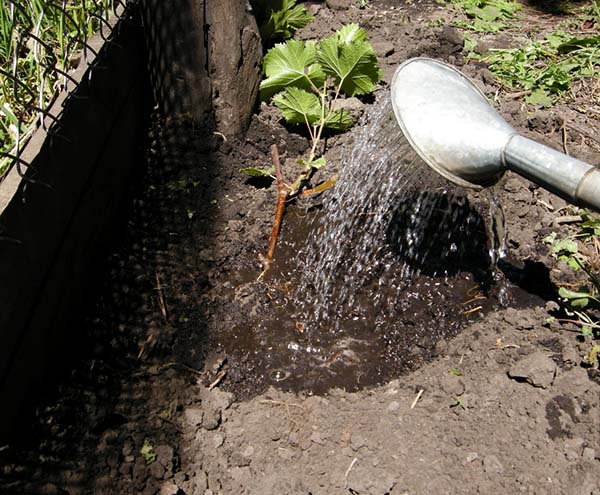
As a rule, young grapes are watered Once every 1-2 weeks (in the absence of rain), while for 1 bush spent 10 to 20 liters of water (depending on the degree of drying out of the soil) and necessarily in the holesmade around the seedling.
Advice! It will be very good (desirable) if you periodically combine watering with top dressing (for example, using the same solution of bird droppings or slurry).
When to water grapes: ohanswers to frequently asked questions about watering
Watering of grapes is carried out during the entire growing season, depending on the needs of the plant at certain periods of growth and fruiting.
There are 3 main periods (not counting moisture recharge) when grapes need abundant watering:
- At the time of bud break and the start of shoot growth (2 weeks before flowering).
- After flowering (after 1-2 weeks, when the ovary reaches the size of a pinhead, and then every 2 weeks).
- During the period of intensive growth and filling of berries (before their color and even more sugar, technical maturity).
The last period is the most important, because it is due to moisture that the berries will be poured.
Many novice growers ask the same questions about the timing of watering grapes (by growing season), then the most popular of them are collected, and detailed answers are given.
Video: when and how to water grapes
How to water grapes in spring
If the groundwater under your vineyard is located deep enough and / or there was a dry, snowless winter, then in order to saturate the bushes with the necessary moisture to start active sap flow in the shoots, you should carry out spring watering watering, of course, having time to do this before bud break or after.
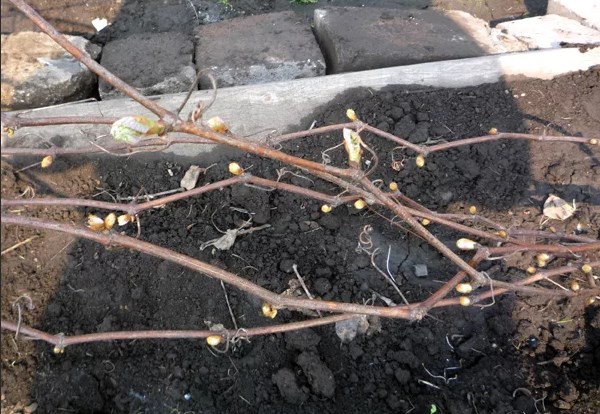
Water consumption during water charging grapes in spring for 1 adult bush - from 50 to 100 liters.
Important! If you did the autumn water-charging irrigation, then you do not need to do the spring irrigation, especially if the winter was snowy and the soil is saturated with moisture. Otherwise (too much moisture), you will only harm your bushes.
Video: watering grapes in spring
Do I need to water the grapes during flowering
No, watering is recommended before (in 2 weeks) and after flowering (after 1-2 weeks, when the ovary reaches the size of a pinhead).
The fact is that watering the grapes during the flowering period can lead to shedding flowers and ovary.
In other words, excess moisture during flowering causes “peas of grapes "and the thinness of its bunches.
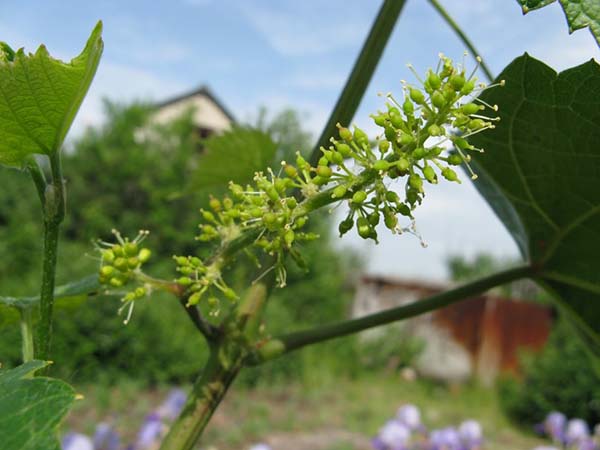
Do I need to water the grapes at the beginning of berry ripening
Let's say that the berries on your vines are already start to color, soften, in short, gradually mature.
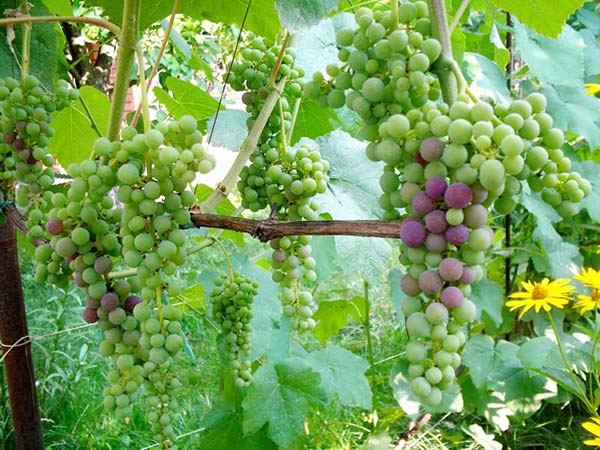
This is where the debate arises as to whether it is possible to continue to water the grapes during this period.
- Opponents of watering claim that watering during this period is mandatory will negatively affect berries: they can start to "crack" and lose some of the sugars.
- On the contrary, watering supporters cite as an argument the fact that many varieties precisely during the period of color acquisition and before ripening gain up to 40-50% of their mass... Also, if at this moment they will be in the ground nutrientsthen without water they just will not be able to get into the bush to improve the size and flavor of your berries.
As for the frequency and rate of watering, it is not worth giving the grapes an excessive amount of moisture during this period, in other words, watering should be reduced. For example, per adult 5-year-old bush will be enough 30-40 liters of water per week.
Of course one should always look at the state of the soil, and if it is wet, then do not water, dry - water.
During this period, your main enemy is sudden rain, which can cause the berries to crack.
Is it possible to water grapes after staining berries during the period of accumulation of sugars
Another thing is when the berries are completely colored, gain weight, and the process of sugar accumulation begins in them, from this moment of the beginning of technical ripening, everyone watering must be stopped.
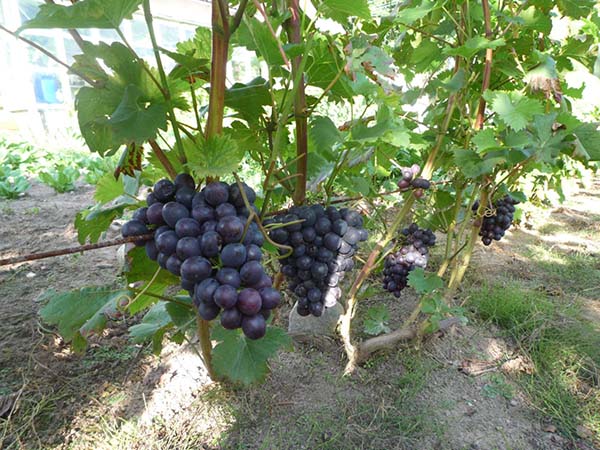
Note! If this is not done, then with every watering you will simply reduce the amount of sugars in your berries, moreover, it will definitely lead to their cracking and substantial delayed maturation.
In addition, continued watering may negatively affect the condition and wintering of the bushes themselvessince excess moisture in the soil will be stimulate growth processes in grape shootswhich in turn will lead to delay their ripening and preparing grapes for winter.
Do I need to water the grapes in autumn
There is no need to continue watering the grapes after fruiting. However, closer to mid-late autumn it is worth doing autumn water-charging irrigation after the leaves have fallen (in fact, it is possible even earlier, when the leaves are just beginning to fall) and pruning vinesbut before shelter for the winter.
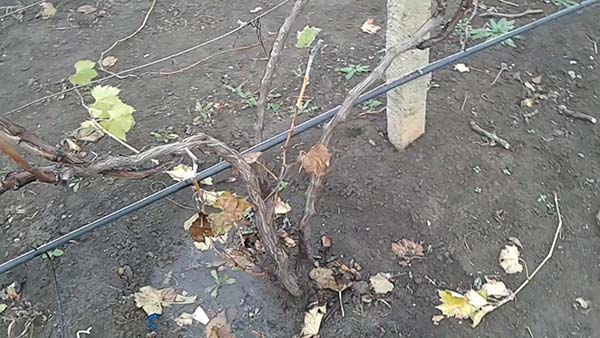
The purpose of this watering is to saturate the root layer of the plant with moisture before wintering, due to which it will freeze the ground less (in other words, grape bushes will definitely not freeze out, of course, if you cover correctly for the wintersince wet soil has a higher heat capacitythan dry.
By the way! If autumn is very rainy, then, of course, there is no point in doing water-charging irrigation.
Video: water charging grapes in the fall + watering methods
Ways of watering grapes
Let's talk about the most popular and effective ways of watering grapes.
Surface watering
Most beginner inexperienced summer residents use this particular type of irrigation, however, it the most ineffective and unsafe (for grapes).
The fact is that grapes the root system is not superficial, like most berry crops - the same currants, gooseberries, raspberries, especially strawberries, and deep.
In other words, due to surface watering, the roots of the grapes will not deepen, which will negatively affect their wintering (the roots may simply freeze out).
Accordingly, in order for the nutrient moisture to reach the root layer, you need a very large amount of moisture. It should be borne in mind that Substantial part simply evaporate from the surface, and this, in turn, will increase the humidity of the air, which can cause, or rather create favorable conditions for the development of various fungal diseases (for example, the same mildew).
However! Such watering is suitable for 1-2 summer bushes, and here for adults and fruiting necessary organize a more correct method of delivering moisture to the root layer in one of the following ways.
Watering in grooves, trenches or pits
Along the rows of grape bushes, departing from their base by 60-90 centimeters (in some sources it is recommended to step back from the trunk up to 1 meter), grooves (pits or trenches) 30-40 centimeters deep (one and a half bayonets of a shovel) are dug out, and even better 50- 60 cm.
Accordingly, you water (put the hose) into these recesses and the water almost immediately enters the root zone.
Idea! Or you can just dig 4 holes around each bush (if there are not many bushes), pouring a bucket of water into each, but be sure to fill it up after the moisture has been absorbed.

By the way! Some growers after each such watering, they bury (cover with earth) this grooveso that to avoid the slightest evaporation of moisture (which is especially actual in summer, but in spring and autumn this can be omitted).
Drip irrigation
Indeed, drip irrigation is perhaps the most modern and efficient way of irrigation.
However! If you have small vineyardthen no point in that nosince the equipment is by no means cheap.
Another thing is if you (in your region) in summer is very hot and dry, there is little natural precipitation, or you have a large vineyard (more than 10-30 bushes), then drip irrigation is a completely reasonable solution to the problem.
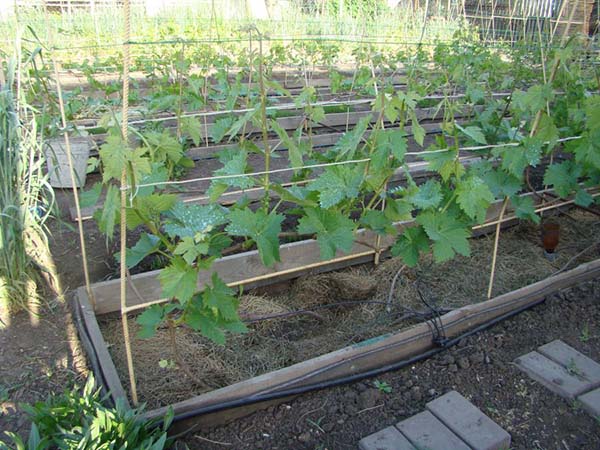
Underground watering (through pipes and drainage wells) is the most popular and effective method for summer residents
How to organize underground watering of grapes through the pipes:
- at a distance of 50-60 centimeters from the base of the bush (in some sources it is recommended to retreat from the trunk up to 1 meter), recesses for pipes are dug (to a depth of at least 30-40 cm, and even 40-60 cm is better);
- in the lower part of the pipe (lower 15-20 cm) holes are made around the circumference;
- so that the pipe does not get clogged, then the lower part with holes is wrapped in agrofibre and is well fixed (with tape and twine);
- the pipe is inserted into a hole in the ground;
- in this case, the upper edge of the pipe should stick out 15-20 centimeters above the ground (for ventilation).
Important! To prevent moisture from evaporating, be sure to close the pipe with some kind of cap (plug).
Respectively, watering grapes carried out straight into this pipe, thereby nutrient moisture enters (is delivered) directly to the roots of the plant.
An undeniable advantage! Thanks to underground watering disappears any need for loosening the soilsince water does not reach the surface.
And you can do not just watering through pipes, but watering along drainage pits (wells).
By the way! Drainage wells are great for organizing irrigation individual bushes.
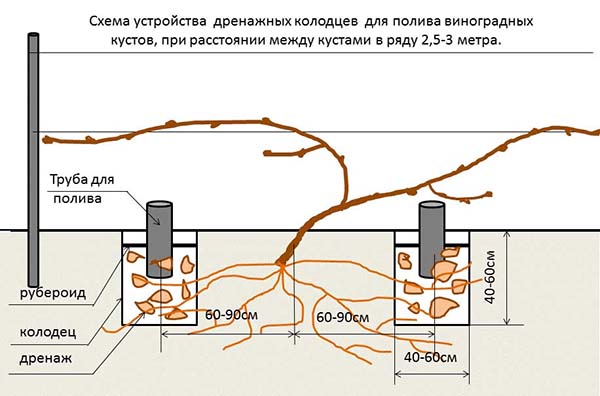
Principle of creation underground drainage well for watering grapes:
- stepping back from the base by 50-60 centimeters (in some sources it is recommended to step back from the stem up to 1 meter), dig a hole - 40-60 in depth and 40-60 in diameter (on average - 50 by 50 cm);
- pour a little humus on the bottom (it will be used as a long-acting fertilizer);
- then lay a 15-20 cm drainage layer of crushed stone (it is better expanded clay crushed stone);
Worth knowing! 30-40 liters of crushed stone volume ("drainage") are freely filled with 10-20 liters of water at one time.
- directly into the rubble, half of its layer (you can go a little deeper), insert the end of the filler pipe;
- then cover it with plastic wrap, roofing felt or pieces of linoleum (to prevent rubble from silting up) and cover it with earth.
It is even better to pour gravel or sand on top of the crushed stone layer and around the pipe with a layer of 10 cm. it will not only protect the crushed stone from silting up, but will also enable the free growth of roots.
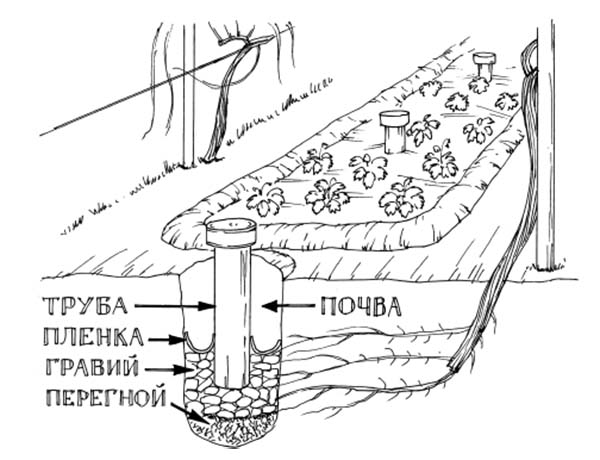
By the way! As pipes for irrigation, as a rule, plastic or asbestos-cement pipes with a diameter of 50 to 100 mm are used.
The essence of irrigation remains unchanged (water enters the root layer immediately), only in this case you fill your drainage well with water (until it starts to flow), while moisture lasts longer and is used up gradually.
Important! To prevent moisture from evaporating, be sure to close the pipe with some kind of cap (plug).
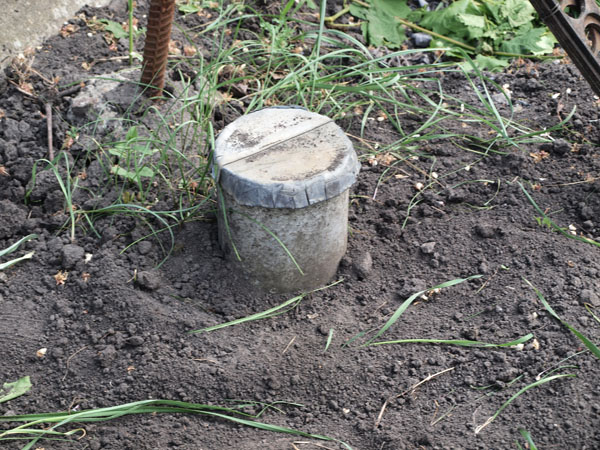
Idea! You can not just bury the pipes vertically, but make a mini-plumbing by laying it horizontally. To do this, you need to dig a ditch along the entire length of the row spacing, into which you then lay the leaky pipe (both ends of the pipe must be brought to the surface), of course, before drilling several holes in it (with a diameter of 5-7 mm approximately every 10-15 cm) along the circumference of the entire length of the pipe so that the water saturates the soil well in the root layer.
Thanks to this method, the roots will grow not only next to the drainage well, but also along the entire length of the trench.
Video: underground watering in the vineyard
By the way! There is a temporary and simpler solution for underground watering (similar to homemade drip irrigation for vegetables): you can simply dig into the ground 5 liter bottles and water through them, first cutting the bottom.
And you can make underground watering of grapes and more stationary (with drainage), using the idea from the following video:
Thus, now you know how to properly water the grapes, when and how often to do it, as well as what methods of watering exist, which means that large harvests are not far off. Good luck, budding growers!
Video: watering the vineyard

